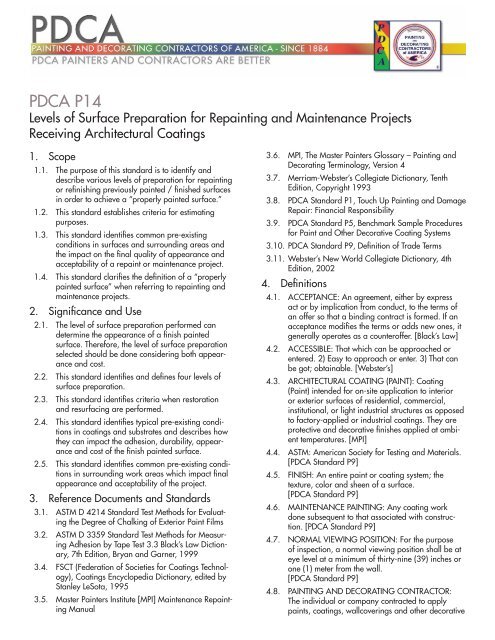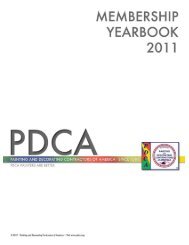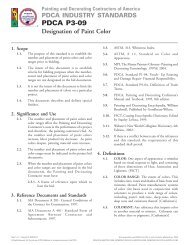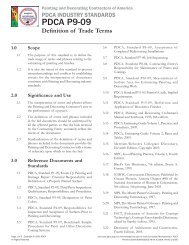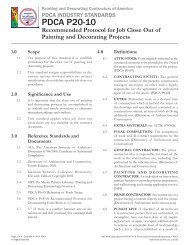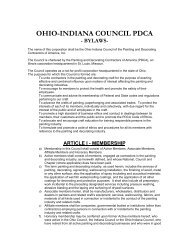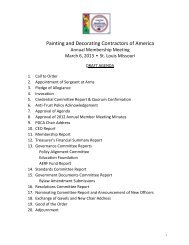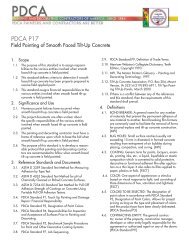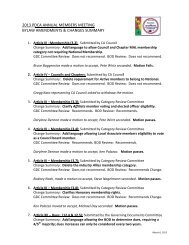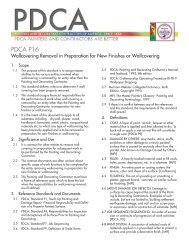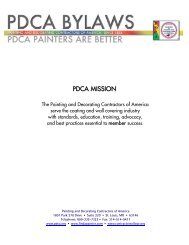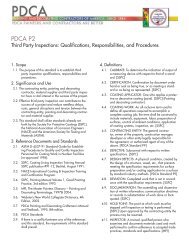Download - Painting and Decorating Contractors of America
Download - Painting and Decorating Contractors of America
Download - Painting and Decorating Contractors of America
Create successful ePaper yourself
Turn your PDF publications into a flip-book with our unique Google optimized e-Paper software.
PDCA P14<br />
Levels <strong>of</strong> Surface Preparation for Repainting <strong>and</strong> Maintenance Projects<br />
Receiving Architectural Coatings<br />
1. Scope<br />
1.1. The purpose <strong>of</strong> this st<strong>and</strong>ard is to identify <strong>and</strong><br />
describe various levels <strong>of</strong> preparation for repainting<br />
or refinishing previously painted / finished surfaces<br />
in order to achieve a “properly painted surface.”<br />
1.2. This st<strong>and</strong>ard establishes criteria for estimating<br />
purposes.<br />
1.3. This st<strong>and</strong>ard identifies common pre-existing<br />
conditions in surfaces <strong>and</strong> surrounding areas <strong>and</strong><br />
the impact on the final quality <strong>of</strong> appearance <strong>and</strong><br />
acceptability <strong>of</strong> a repaint or maintenance project.<br />
1.4. This st<strong>and</strong>ard clarifies the definition <strong>of</strong> a “properly<br />
painted surface” when referring to repainting <strong>and</strong><br />
maintenance projects.<br />
2. Significance <strong>and</strong> Use<br />
2.1. The level <strong>of</strong> surface preparation performed can<br />
determine the appearance <strong>of</strong> a finish painted<br />
surface. Therefore, the level <strong>of</strong> surface preparation<br />
selected should be done considering both appearance<br />
<strong>and</strong> cost.<br />
2.2. This st<strong>and</strong>ard identifies <strong>and</strong> defines four levels <strong>of</strong><br />
surface preparation.<br />
2.3. This st<strong>and</strong>ard identifies criteria when restoration<br />
<strong>and</strong> resurfacing are performed.<br />
2.4. This st<strong>and</strong>ard identifies typical pre-existing conditions<br />
in coatings <strong>and</strong> substrates <strong>and</strong> describes how<br />
they can impact the adhesion, durability, appearance<br />
<strong>and</strong> cost <strong>of</strong> the finish painted surface.<br />
2.5. This st<strong>and</strong>ard identifies common pre-existing conditions<br />
in surrounding work areas which impact final<br />
appearance <strong>and</strong> acceptability <strong>of</strong> the project.<br />
3. Reference Documents <strong>and</strong> St<strong>and</strong>ards<br />
3.1. ASTM D 4214 St<strong>and</strong>ard Test Methods for Evaluating<br />
the Degree <strong>of</strong> Chalking <strong>of</strong> Exterior Paint Films<br />
3.2. ASTM D 3359 St<strong>and</strong>ard Test Methods for Measuring<br />
Adhesion by Tape Test 3.3 Black’s Law Dictionary,<br />
7th Edition, Bryan <strong>and</strong> Garner, 1999<br />
3.4. FSCT (Federation <strong>of</strong> Societies for Coatings Technology),<br />
Coatings Encyclopedia Dictionary, edited by<br />
Stanley LeSota, 1995<br />
3.5. Master Painters Institute [MPI] Maintenance Repainting<br />
Manual<br />
3.6. MPI, The Master Painters Glossary – <strong>Painting</strong> <strong>and</strong><br />
<strong>Decorating</strong> Terminology, Version 4<br />
3.7. Merriam-Webster’s Collegiate Dictionary, Tenth<br />
Edition, Copyright 1993<br />
3.8. PDCA St<strong>and</strong>ard P1, Touch Up <strong>Painting</strong> <strong>and</strong> Damage<br />
Repair: Financial Responsibility<br />
3.9. PDCA St<strong>and</strong>ard P5, Benchmark Sample Procedures<br />
for Paint <strong>and</strong> Other Decorative Coating Systems<br />
3.10. PDCA St<strong>and</strong>ard P9, Definition <strong>of</strong> Trade Terms<br />
3.11. Webster’s New World Collegiate Dictionary, 4th<br />
Edition, 2002<br />
4. Definitions<br />
4.1. ACCEPTANCE: An agreement, either by express<br />
act or by implication from conduct, to the terms <strong>of</strong><br />
an <strong>of</strong>fer so that a binding contract is formed. If an<br />
acceptance modifies the terms or adds new ones, it<br />
generally operates as a counter<strong>of</strong>fer. [Black’s Law]<br />
4.2. ACCESSIBLE: That which can be approached or<br />
entered. 2) Easy to approach or enter. 3) That can<br />
be got; obtainable. [Webster’s]<br />
4.3. ARCHITECTURAL COATING (PAINT): Coating<br />
(Paint) intended for on-site application to interior<br />
or exterior surfaces <strong>of</strong> residential, commercial,<br />
institutional, or light industrial structures as opposed<br />
to factory-applied or industrial coatings. They are<br />
protective <strong>and</strong> decorative finishes applied at ambient<br />
temperatures. [MPI]<br />
4.4. ASTM: <strong>America</strong>n Society for Testing <strong>and</strong> Materials.<br />
[PDCA St<strong>and</strong>ard P9]<br />
4.5. FINISH: An entire paint or coating system; the<br />
texture, color <strong>and</strong> sheen <strong>of</strong> a surface.<br />
[PDCA St<strong>and</strong>ard P9]<br />
4.6. MAINTENANCE PAINTING: Any coating work<br />
done subsequent to that associated with construction.<br />
[PDCA St<strong>and</strong>ard P9]<br />
4.7. NORMAL VIEWING POSITION: For the purpose<br />
<strong>of</strong> inspection, a normal viewing position shall be at<br />
eye level at a minimum <strong>of</strong> thirty-nine (39) inches or<br />
one (1) meter from the wall.<br />
[PDCA St<strong>and</strong>ard P9]<br />
4.8. PAINTING AND DECORATING CONTRACTOR:<br />
The individual or company contracted to apply<br />
paints, coatings, wallcoverings <strong>and</strong> other decorative
PDCA INDUSTRY STANDARDS PDCA P14<br />
finishes. [PDCA St<strong>and</strong>ard P9]<br />
4.9. PREPARATION: The act or process <strong>of</strong> preparing.<br />
(Prepare, to make ready, usually for a specific<br />
purpose; make suitable) (Performance <strong>of</strong> the specified<br />
procedures prior to the application <strong>of</strong> paint,<br />
coating, wallcovering or other decorative finish.)<br />
[Webster’s] [PDCA St<strong>and</strong>ard P9]<br />
4.10. QUALITY OF APPEARANCE: Aesthetics; conception<br />
<strong>of</strong> beauty, a particular taste for or approach to<br />
what is pleasing to the senses <strong>and</strong> especially sight.<br />
[Merriam-Webster’s]<br />
4.11. SPECIFICATION: A clear accurate description <strong>of</strong> the<br />
technical requirement for material products, or services,<br />
which specifies the minimum requirement for<br />
quality <strong>and</strong> construction <strong>of</strong> materials <strong>and</strong> equipment<br />
necessary for an acceptable product. In general,<br />
specifications are in the form <strong>of</strong> written descriptions,<br />
drawings, prints, commercial designations, industry<br />
st<strong>and</strong>ards <strong>and</strong> other descriptive references. [FSCT]<br />
4.12. SUBSTRATE: A variant <strong>of</strong> substratum. In painting,<br />
any surface to be painted, including wood,<br />
concrete, masonry, steel, other metals, <strong>and</strong> various<br />
other materials or previous paints. A substrate<br />
can, therefore, be bare or covered. A previously<br />
unpainted surface sometimes is called the “original<br />
substrate.” [MPI]<br />
4.13. SURFACE: The substrate to which paints, coatings,<br />
or wallcoverings are applied; the finish obtained<br />
after the coating work has been completed. [PDCA<br />
St<strong>and</strong>ard P9]<br />
5. St<strong>and</strong>ard Specification<br />
5.1. The MPI Repaint Manual describes the condition <strong>of</strong><br />
various paintable surfaces <strong>and</strong> substrates <strong>and</strong> rates<br />
them in order <strong>of</strong> degree <strong>of</strong> surface degradation<br />
(DSD) as follows:<br />
DSD-0 Sound Surface<br />
DSD-1 Slightly Deteriorated Surface DSD-2 Moderately<br />
Deteriorated Surface<br />
DSD-3 Severely Deteriorated Surface<br />
DSD-4 Substrate Damage<br />
The MPI Repaint Manual further describes various<br />
repaint surface preparation techniques labeled RSP<br />
1 through RSP 13 that may be appropriate depending<br />
upon the condition <strong>of</strong> the surfaces to be painted.<br />
5.2. This st<strong>and</strong>ard recognizes that project specifications<br />
detailing the type <strong>and</strong> extent <strong>of</strong> surface preparation<br />
to be performed shall take precedence over other<br />
considerations.<br />
5.3. This st<strong>and</strong>ard recommends that specifications be<br />
modeled after the MPI Maintenance Repainting<br />
Manual.<br />
5.4. Levels <strong>of</strong> Surface Preparation<br />
5.4.1. Level 1: Basic: This surface preparation level<br />
requires basic cleanliness <strong>of</strong> surfaces to ensure<br />
the adhesion <strong>of</strong> new finishes to the surfaces to<br />
which they are applied with less concern for the<br />
adhesion <strong>of</strong> existing paint coats <strong>and</strong> quality <strong>of</strong><br />
appearance <strong>of</strong> the finished surfaces. Preparation<br />
shall include the removal <strong>of</strong> surface dust,<br />
dirt, obvious loose paint <strong>and</strong> other surface<br />
contaminants by washing, light power washing<br />
or pressure washing (MPI RSP-5), h<strong>and</strong> cleaning<br />
(MPI RSP<strong>Painting</strong> 1) including the use <strong>of</strong> a<br />
duster brush or broom, <strong>and</strong> mildew treatment<br />
(MPI RSP-9). This level <strong>of</strong> preparation should<br />
ensure that subsequently applied coats <strong>of</strong> paint<br />
will adhere to existing paint coats. This level <strong>of</strong><br />
surface preparation does not warrant that previously<br />
applied paint coats are well adhered to<br />
each other or are well adhered to the substrate.<br />
Under this level <strong>of</strong> preparation no alteration <strong>of</strong><br />
the existing surface pr<strong>of</strong>ile shall be attained. It<br />
is recommended that tests should be performed<br />
on exterior surfaces in accordance with ASTM D<br />
4214 St<strong>and</strong>ard Test Methods for Evaluating the<br />
Degree <strong>of</strong> Chalking <strong>of</strong> Exterior Paint Films. This<br />
level <strong>of</strong> surface preparation is normally recommended<br />
only on surfaces rated DSD-0 or DSD-1.<br />
5.4.2. Level 2: St<strong>and</strong>ard: This surface preparation level<br />
requires basic cleanliness <strong>of</strong> surface to ensure the<br />
adhesion <strong>of</strong> new finishes to the surfaces to which<br />
they are applied as well as the examination <strong>of</strong><br />
existing coatings to assess their adhesion. With<br />
this level <strong>of</strong> surface preparation, good adhesion<br />
<strong>and</strong> longevity <strong>of</strong> finish is <strong>of</strong> primary concern <strong>and</strong><br />
appearance is <strong>of</strong> secondary concern. This level<br />
<strong>of</strong> surface preparation includes that described in<br />
Level 1 plus other procedures necessary to create<br />
a sound surface for repainting including solvent<br />
cleaning (MPI-RSP-2), basic patching/filling,<br />
caulking, light s<strong>and</strong>ing/abrading, <strong>and</strong> “feather<br />
edge” s<strong>and</strong>ing. Under this level <strong>of</strong> surface<br />
preparation, it is recommended that adhesion by<br />
tape tests be performed in general accordance<br />
with ASTM St<strong>and</strong>ard 3359 to assess the adhesion<br />
<strong>of</strong> previously applied paints. It is recommended<br />
that at least three tests be performed at<br />
r<strong>and</strong>omly selected locations where it is apparent<br />
that different paint systems have been previously<br />
applied. When poor results are obtained (ratings<br />
<strong>of</strong> 0 or 1), at isolated locations, then more<br />
aggressive surface preparation methods including<br />
power tool cleaning (MPI RSP-4,) high pressure<br />
washing <strong>and</strong> hydroblasting (MPI-RSP-5,)<br />
chemical stripping (MPI RSP-6) <strong>and</strong> abrasive<br />
blasting (MPI RSP-7) may be recommended at<br />
these isolated locations. If it is determined that
PDCA INDUSTRY STANDARDS PDCA P14<br />
the poor adhesion <strong>of</strong> existing coatings is not<br />
isolated, but is widespread, then restoration/<br />
resurfacing is required. It should be recognized<br />
that many factors may affect the adhesion <strong>of</strong> the<br />
entire coating system that is applied including the<br />
properties <strong>of</strong> the coatings selected, their permeability,<br />
etc. Therefore, while the performance<br />
<strong>of</strong> adhesion tests provides some indication <strong>of</strong><br />
the adhesion <strong>of</strong> existing coatings, they may not<br />
predict the overall adhesion <strong>of</strong> the total coating<br />
system after new coats have been applied. Under<br />
this level <strong>of</strong> preparation the surface pr<strong>of</strong>ile is not<br />
altered unless due to the removal <strong>of</strong> unsound<br />
previously applied paint, <strong>and</strong> that only obvious<br />
existing defects causing abrupt surface pr<strong>of</strong>ile<br />
differences exceeding 1/8 inch or 125 mils will<br />
be corrected. This level <strong>of</strong> surface preparation is<br />
normally recommended only on surfaces rated<br />
DSD-0, DSD-1 or DSD-2.<br />
5.4.3. Level 3: Superior: This surface preparation level<br />
incorporates the requirements <strong>of</strong> Levels 1 <strong>and</strong> 2<br />
with added emphasis on the quality <strong>of</strong> appearance<br />
<strong>of</strong> finish painted surfaces. This level <strong>of</strong><br />
surface preparation includes filling, patching,<br />
taping cracks in drywall <strong>and</strong> properly dealing<br />
with “nail pops,” approximate matches to existing<br />
textures, <strong>and</strong> thorough s<strong>and</strong>ing to minimize<br />
existing runs, sags, brush/roller marks, <strong>and</strong> the<br />
surface pr<strong>of</strong>ile <strong>of</strong> cracked <strong>and</strong> peeling areas,<br />
<strong>and</strong> other existing surface defects. Under this<br />
level <strong>of</strong> preparation the general surface pr<strong>of</strong>ile is<br />
retained but defects causing abrupt surface pr<strong>of</strong>ile<br />
differences exceeding 1/16 inch or 62.5 mils<br />
will be corrected. This level <strong>of</strong> surface preparation<br />
is normally recommended only on surfaces<br />
rated DSD-0, DSD-1 or DSD-2.<br />
5.4.4. Level 4: Supreme: This surface preparation level<br />
incorporates the requirements <strong>of</strong> Levels 1, 2 <strong>and</strong><br />
3 with even more emphasis on the quality <strong>of</strong><br />
appearance <strong>of</strong> finish painted surfaces. Under this<br />
level <strong>of</strong> surface preparation, all necessary preparation<br />
techniques will be employed to improve<br />
the quality <strong>of</strong> appearance except restoration/<br />
resurfacing. Thorough filling <strong>and</strong> s<strong>and</strong>ing will be<br />
accomplished to eliminate defects causing abrupt<br />
surface pr<strong>of</strong>ile differences exceeding 1/32 inch<br />
or 31 mils. This level <strong>of</strong> surface preparation is<br />
normally recommended only on surfaces rated<br />
DSD-0, DSD-1 or DSD-2.<br />
5.5. Restoration/Resurfacing: This degree <strong>of</strong> surface<br />
preparation is required when existing conditions<br />
indicate that the surfaces are severely deteriorated<br />
(DSD-3) or there is substrate damage (DSD-4).<br />
Existing coatings may be completely, or nearly<br />
completely removed (for example stripping to<br />
repaint rather that stripping to stain). Abra-<br />
sion, chemical removers or applied heat may be<br />
employed in order to remove a failed coating<br />
<strong>and</strong>/or to expose a failing substrate. Substrates<br />
may have to be completely replaced, repaired or<br />
resurfaced.<br />
5.6. Inspection <strong>and</strong> Acceptance: Unless otherwise clearly<br />
defined in the project documents, the criteria for<br />
acceptance <strong>of</strong> finish painted surfaces shall be that<br />
<strong>of</strong> a properly painted surface as defined by PDCA<br />
St<strong>and</strong>ard P1-04. It states: A “properly painted<br />
surface” is defined as uniform in appearance, color,<br />
texture, hiding <strong>and</strong> sheen. It is also free <strong>of</strong> foreign<br />
material, lumps, skins, runs, sags, holidays, misses,<br />
or insufficient coverage. It is also a surface free <strong>of</strong><br />
drips, spatters, spills or overspray caused by the<br />
painting <strong>and</strong> decorating contractor’s workforce.<br />
In order to determine whether a surface has been<br />
“properly painted” it shall be examined without<br />
magnification at a distance <strong>of</strong> thirty-nine (39) inches<br />
or one (1) meter, or more, under finished lighting<br />
conditions <strong>and</strong> from a normal viewing position.<br />
However, it should be understood that when applied<br />
to this st<strong>and</strong>ard for repaint <strong>and</strong> maintenance painting,<br />
the defects listed above are not allowed in the<br />
newly applied coats applied by the painting <strong>and</strong><br />
decorating contractor, but depending on the level<br />
<strong>of</strong> preparation selected, may still be visible from<br />
previously applied existing coatings. When Level<br />
4 is selected as the level <strong>of</strong> surface preparation<br />
required, then the criteria for inspection <strong>and</strong> acceptance<br />
may include smoothness to “touch <strong>and</strong> feel” on<br />
interior h<strong>and</strong>rails, doors <strong>and</strong> easily accessible trim.<br />
5.7. The painting <strong>and</strong> decorating contractor shall be<br />
responsible to provide adequate protection <strong>of</strong> existing<br />
surfaces from misplaced paint being applied,<br />
but unless specifically indicated in the project specifications<br />
or contract, is not responsible for pre-existing<br />
conditions in the surrounding work area. This<br />
includes misplaced paint on hardware <strong>and</strong> other<br />
fixtures, surfaces damaged by others (for example,<br />
screening), damage to l<strong>and</strong>scape <strong>and</strong> hardscape,<br />
<strong>and</strong> worn <strong>and</strong> weathered fixtures, hardware, <strong>and</strong><br />
other items.<br />
5.8. Project specifications may require different levels <strong>of</strong><br />
preparation on different surfaces for example, Level<br />
4 on doors <strong>and</strong> trim <strong>and</strong> Level 2 on walls.<br />
5.9. Specifications not specifically stating the level <strong>of</strong><br />
preparation to be attained will be assumed to imply<br />
Level 2.<br />
6. Comments<br />
6.1. This st<strong>and</strong>ard establishes <strong>and</strong> describes levels <strong>of</strong><br />
surface preparation on repainting <strong>and</strong> maintenance<br />
projects.<br />
6.2. This st<strong>and</strong>ard clarifies the level <strong>of</strong> surface prepara-
PDCA INDUSTRY STANDARDS PDCA P14<br />
tion for estimating purposes.<br />
6.3. This st<strong>and</strong>ard defines a protocol for the<br />
inspection <strong>and</strong> acceptance <strong>of</strong> finish painted<br />
surfaces on repaint <strong>and</strong> maintenance<br />
projects.<br />
6.4. This st<strong>and</strong>ard defines pre-existing conditions<br />
that are beyond the responsibility <strong>of</strong><br />
the painting <strong>and</strong> decorating contractor.<br />
6.5. Existing coatings <strong>and</strong> substrates may<br />
contain materials such as lead <strong>and</strong> other<br />
RCRA metals, mold, asbestos, <strong>and</strong> PCBs.<br />
Though abatement <strong>of</strong> those materials may<br />
not be required, EPA, OSHA, state <strong>and</strong><br />
local regulations regarding environmental,<br />
health <strong>and</strong> disposal requirements must be<br />
considered.nd disposal requirements must<br />
be considered.<br />
7. Disclaimer <strong>of</strong> Liability<br />
7.1. PDCA does not warrant or assume any<br />
legal liability or responsibility for the accuracy,<br />
completeness or usefulness <strong>of</strong> any <strong>of</strong><br />
the information contained herein.


